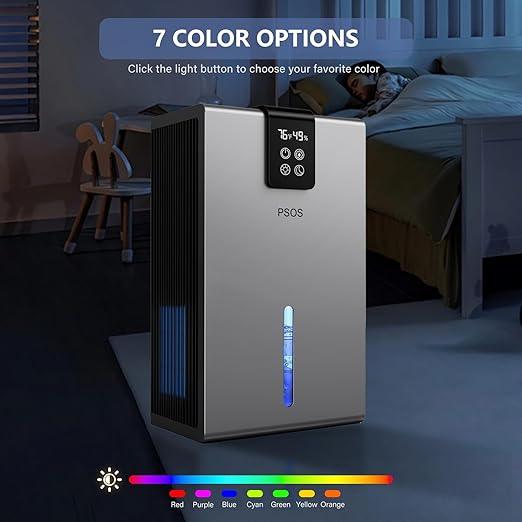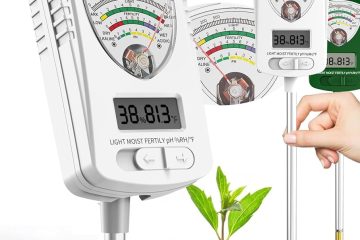I remember the day I stepped into my basement, and it hit me—that unmistakable musty smell, a chill in the air, and a lingering dampness. It was time to get serious about buying a dehumidifier. But as I dove into research, I quickly realized that choosing the right type was far from simple. Should I go with a desiccant dehumidifier or a refrigerant dehumidifier?
This decision isn’t just about budget or size; it’s about understanding how each type works, what spaces they’re best suited for, and which option can be most efficient and affordable in the long run. In this article, I’ll walk you through everything I learned to help you make the best decision for your own space.

Table of Contents
ToggleWhat’s a Dehumidifier, and How Does It Work?
At its core, a dehumidifier’s job is simple: it removes excess moisture from the air, making your space more comfortable and protecting it from dampness, mold, and mildew. This is especially useful in basements, bathrooms, laundry rooms, or any place that naturally retains moisture.
What is a Dehumidifier? A dehumidifier is a household device that draws in humid air, removes the excess moisture, and releases drier air back into the room. This keeps humidity levels balanced, which can improve indoor air quality, prevent mold growth, and protect belongings.
How Dehumidifiers Help Improve Indoor Air Quality By lowering humidity, dehumidifiers create a healthier living environment. Mold and dust mites thrive in moist conditions, so keeping humidity levels under control can reduce respiratory issues, allergies, and skin irritation.
Desiccant Dehumidifiers: An In-Depth Look
Desiccant dehumidifiers first caught my attention because they don’t have a compressor or cooling coils. Instead, they use an absorbent material, usually silica gel, to capture moisture from the air.
How Desiccant Dehumidifiers Work
These dehumidifiers pull in air and pass it over a desiccant wheel coated in a moisture-absorbing material. As the air travels through, moisture sticks to the desiccant. The unit then heats the desiccant to release the moisture into a water tank or outside through an exhaust pipe.
Ideal Conditions for Desiccant Dehumidifiers
Desiccant dehumidifiers are known for their ability to work efficiently in lower temperatures, which makes them ideal for cooler environments. If you need to control humidity in a garage, basement, or any space that’s cold, a desiccant model might be a great fit.
Advantages of Desiccant Dehumidifiers
- Effective in Cooler Climates: Desiccant dehumidifiers perform better in cold rooms where refrigerant models may struggle.
- Quiet Operation: They typically run quietly, making them suitable for places where you don’t want extra noise.
- Lightweight and Portable: Desiccant models are often lighter and easier to move around.
Drawbacks of Desiccant Dehumidifiers
However, desiccant dehumidifiers can consume more electricity and may not be as cost-efficient in warmer spaces. They’re also generally designed for smaller areas.
Refrigerant Dehumidifiers: How They Stack Up
When I learned about refrigerant dehumidifiers, I discovered they function a lot like mini air conditioners. They cool the air down to pull out the moisture.
How Refrigerant Dehumidifiers Work
Refrigerant models draw in humid air and pass it over cooling coils. As the air cools, it condenses, leaving moisture droplets that collect in a reservoir or drain out through a hose.
Best Use Scenarios for Refrigerant Dehumidifiers
These units excel in warm, humid areas where they’re highly efficient. They’re best for rooms with steady temperatures, such as living rooms, bedrooms, or any large space with consistent warmth.
Advantages of Refrigerant Dehumidifiers
- Efficient in Warm, Humid Environments: They work faster and more efficiently when it’s warm.
- Affordable and Energy-Efficient: Generally more cost-effective to operate when conditions are ideal.
- Handles Larger Spaces: They’re powerful enough to manage larger rooms or open areas.
Drawbacks of Refrigerant Dehumidifiers
Refrigerant dehumidifiers can struggle in cooler spaces and are often noisier. They also may need regular defrosting if used in cold environments, which can affect performance.
Are Desiccant Dehumidifiers Better?
To determine which dehumidifier was better, I had to consider my needs: climate, space, and cost.
| Feature | Desiccant Dehumidifier | Refrigerant Dehumidifier |
|---|---|---|
| Best Temperature Range | Works well in cold temperatures | Ideal in warm, humid conditions |
| Energy Consumption | Higher in warm conditions | Lower in warm conditions |
| Noise Level | Generally quieter | Can be louder, especially in larger models |
| Portability | Lightweight and compact | Heavier, typically less portable |
| Maintenance Needs | Low, except for water tank | May need regular defrosting in cold spaces |
| Cost Efficiency | Higher cost in warmer conditions | More cost-effective in warm environments |
When a Desiccant Is a Better Choice
Desiccant models are better suited for colder spaces or environments where portability and noise reduction are priorities. If you live in a climate that gets chilly, particularly in the winter, a desiccant dehumidifier could be a more effective solution.
Which Type of Dehumidifier Is the Most Efficient?
One of my top concerns when shopping for a dehumidifier was energy efficiency. After all, no one wants a device that’s going to drive up the electricity bill!
- Refrigerant Dehumidifiers: These models tend to be more energy-efficient in warm and humid conditions, where they can remove moisture with less effort.
- Desiccant Dehumidifiers: While they consume more energy, they’re better for cold conditions where refrigerants struggle to perform effectively.
Which Type of Dehumidifier Is the Cheapest to Run?
If your space stays warm most of the year, a refrigerant dehumidifier will likely be more affordable to run. However, in colder temperatures, a desiccant model could provide better value by working effectively without frequent defrosting.
Maintenance & Longevity
To keep your dehumidifier running smoothly, regular maintenance is key. Different models have specific needs, but both types require basic care.
Basic Maintenance for Desiccant and Refrigerant Dehumidifiers
- Cleaning the Filters: This should be done at least once a month to ensure optimal air quality.
- Emptying the Water Tank: Regularly empty and clean the tank to prevent mold buildup.
- Check for Frost: Refrigerant models may need defrosting in cooler spaces to avoid performance issues.
Longevity and Replacement
With proper maintenance, a desiccant dehumidifier may last up to 5–8 years, while refrigerant models can last around 8–10 years. Lifespan depends on usage, climate, and care.
Which Dehumidifier Is Right for You?
After testing both types of dehumidifiers, I realized that the best choice depends on personal circumstances. Each type offers unique benefits that can suit specific spaces and climates.
Choosing Based on Climate and Room Conditions
Consider your living environment: if it’s warm and humid, a refrigerant model is likely a better fit. For cooler areas, especially garages or basements, desiccant models are ideal.
Key Takeaways for Making the Best Choice
There’s no one-size-fits-all answer. Understanding your specific needs, budget, and the temperature of your space is essential in choosing the right dehumidifier.
My Dehumidifier Dilemma
When I finally decided to invest in a dehumidifier, I was torn between the desiccant and refrigerant models. Living in a place with chilly winters, I knew a desiccant dehumidifier might be better for my unheated basement. But the energy savings of a refrigerant model in warmer months were appealing too.
In the end, I chose to try both. Testing each model in my basement during different seasons, I quickly noticed that the desiccant dehumidifier kept up well in colder temperatures, while the refrigerant model was better suited to our warm living areas. This experience taught me that choosing a dehumidifier often depends on personal needs, climate, and budget.
- Can the Roomba Combo i5+ Function as Both a Vacuum and a Mop? - November 16, 2024
- Thermopro tp49 Digital Hygrometer Review: Comparing Top Competitors - November 7, 2024
- Eva-Dry wireless mini dehumidifier Review - November 6, 2024


